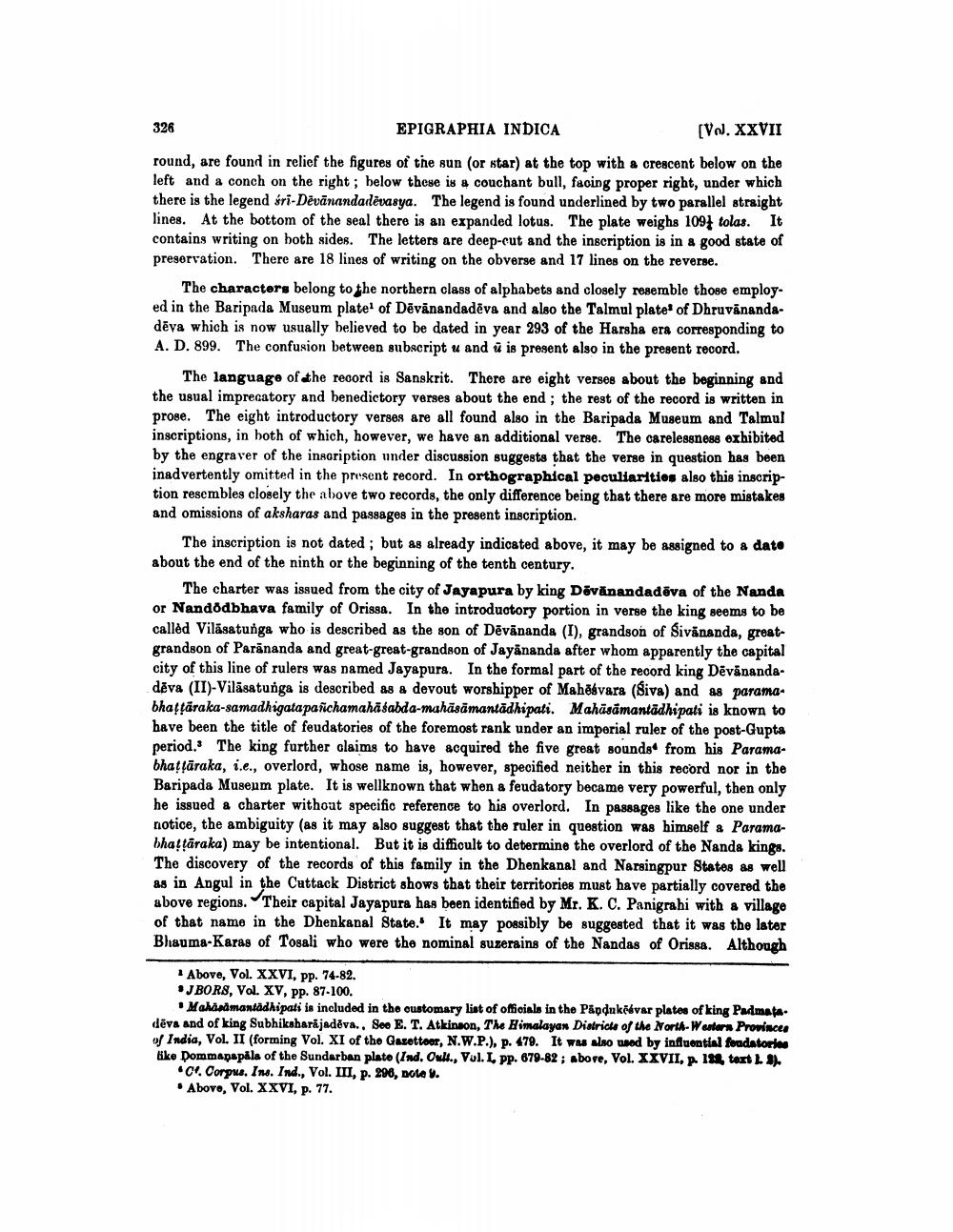________________
EPIGRAPHIA INDICA
[Vol. XXVII
round, are found in relief the figures of the sun (or star) at the top with a crescent below on the left and a conch on the right; below these is a couchant bull, facing proper right, under which there is the legend śri-Devānandadevasya. The legend is found underlined by two parallel straight lines. At the bottom of the seal there is an expanded lotus. The plate weighs 109 tolas. It contains writing on both sides. The letters are deep-cut and the inscription is in a good state of preservation. There are 18 lines of writing on the obverse and 17 lines on the reverse.
326
The characters belong to the northern class of alphabets and closely resemble those employed in the Baripada Museum plate1 of Devanandadeva and also the Talmul plate of Dhruvanandadēva which is now usually believed to be dated in year 293 of the Harsha era corresponding to A. D. 899. The confusion between subscript u and u is present also in the present record.
The language of the record is Sanskrit. There are eight verses about the beginning and the usual imprecatory and benedictory verses about the end; the rest of the record is written in prose. The eight introductory verses are all found also in the Baripada Museum and Talmul inscriptions, in both of which, however, we have an additional verse. The carelessness exhibited by the engraver of the inscription under discussion suggests that the verse in question has been inadvertently omitted in the present record. In orthographical peculiarities also this inscription resembles closely the above two records, the only difference being that there are more mistakes and omissions of aksharas and passages in the present inscription.
The inscription is not dated; but as already indicated above, it may be assigned to a date about the end of the ninth or the beginning of the tenth century.
The charter was issued from the city of Jayapura by king Devanandadeva of the Nanda or Nandödbhava family of Orissa. In the introductory portion in verse the king seems to be called Vilasatunga who is described as the son of Devananda (I), grandson of Sivananda, greatgrandson of Parananda and great-great-grandson of Jayananda after whom apparently the capital city of this line of rulers was named Jayapura. In the formal part of the record king Devanandadēva (II)-Vilasatunga is described as a devout worshipper of Mahesvara (Siva) and as paramabhaṭṭaraka-samadhigata pañchamahāśabda-mahāsāmantādhipati. Mahāsāmantadhipati is known to have been the title of feudatories of the foremost rank under an imperial ruler of the post-Gupta period. The king further claims to have acquired the five great sounds from his Paramabhaṭṭāraka, i.e., overlord, whose name is, however, specified neither in this record nor in the Baripada Museum plate. It is wellknown that when a feudatory became very powerful, then only he issued a charter without specific reference to his overlord. In passages like the one under notice, the ambiguity (as it may also suggest that the ruler in question was himself a Paramabhaṭṭaraka) may be intentional. But it is difficult to determine the overlord of the Nanda kings. The discovery of the records of this family in the Dhenkanal and Narsingpur States as well as in Angul in the Cuttack District shows that their territories must have partially covered the above regions. Their capital Jayapura has been identified by Mr. K. C. Panigrahi with a village of that name in the Dhenkanal State. It may possibly be suggested that it was the later Bhauma-Karas of Tosali who were the nominal suzerains of the Nandas of Orissa. Although
1 Above, Vol. XXVI, pp. 74-82. JBORS, Vol. XV, pp. 87-100.
Mahasamantadhipati is included in the customary list of officials in the Pandukeévar plates of king Padmata. deva and of king Subhiksharajadeva., See E. T. Atkinson, The Himalayan Districts of the North-Western Provinces of India, Vol. II (forming Vol. XI of the Gazetteer, N.W.P.), p. 479. It was also used by influential feudatories like Dommapapala of the Sundarban plate (Ind. Cult., Vol. I, pp. 679-82; above, Vol. XXVII, p. 188, text 1. 3). C. Corpus. Ins. Ind., Vol. III, p. 296, note.
Above, Vol. XXVI, p. 77.




